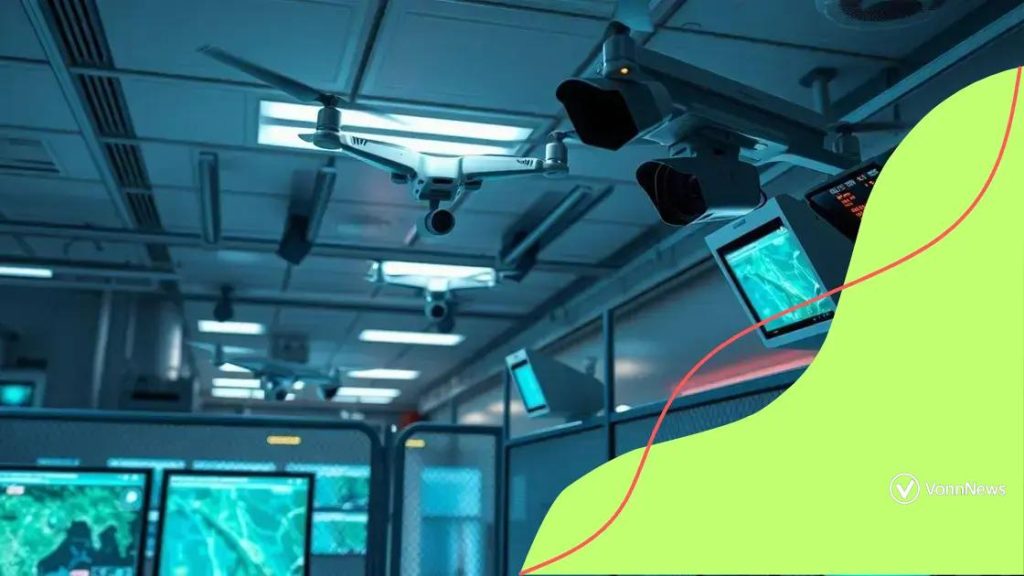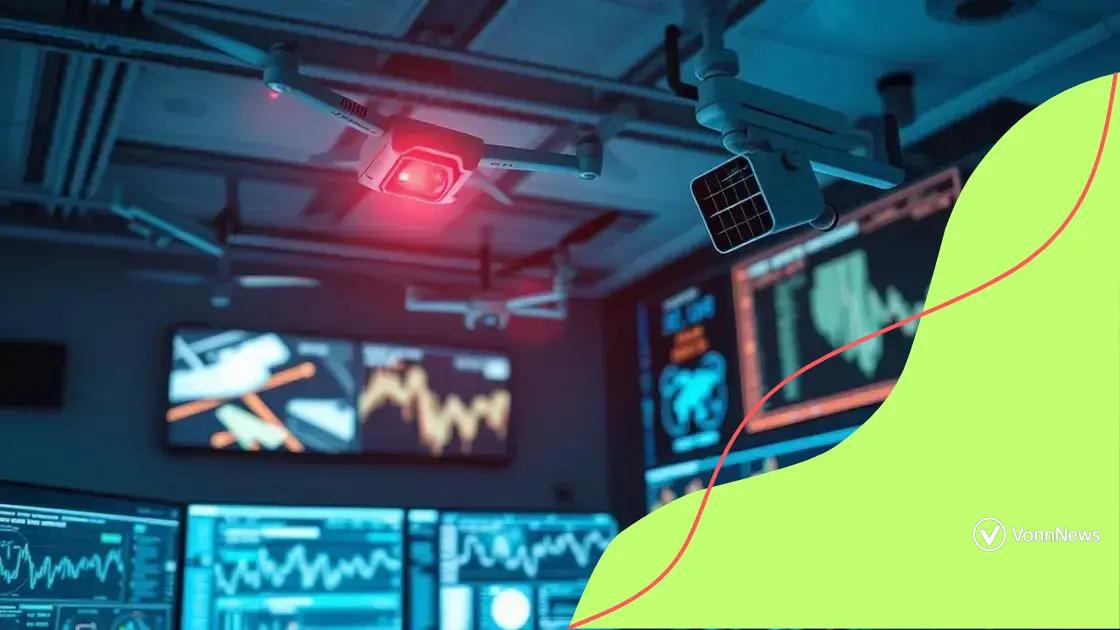Border security technology: enhancing safety and efficiency

Anúncios
Border security technology utilizes advanced tools like artificial intelligence, drones, and data sharing to enhance safety and efficiency, while addressing challenges such as high costs and privacy concerns.
Border security technology plays a crucial role in ensuring the safety of nations worldwide. Have you ever wondered how countries manage their borders effectively? Let’s explore the various technologies that enhance security and improve operational efficiency.
Anúncios
Understanding border security technology
Understanding border security technology is essential in today’s world. It involves a range of tools and systems designed to monitor and safeguard borders. This technology not only enhances security but also ensures the efficient movement of people and goods.
Key Technologies in Border Security
There are several critical technologies that play a vital role in border security. These tools help authorities detect unauthorized crossings and manage legitimate traffic effectively.
- Surveillance cameras: Placed at strategic points, these cameras provide real-time monitoring of border areas.
- Drones: Drones can cover large areas quickly, offering aerial views that enhance situational awareness.
- Biometric systems: These systems use physical characteristics, such as fingerprints or facial recognition, to verify individuals crossing borders.
- Smart fences: Equipped with sensors, smart fences can detect movement and alert border patrols to potential breaches.
Furthermore, the integration of artificial intelligence with border security technology improves the analysis of data collected from these devices. AI processes vast amounts of information quickly, helping decision-makers respond more effectively to threats.
Benefits of Implementing Technologies
Implementing these technologies brings numerous benefits. They streamline border operations and enhance security measures. Travelers enjoy faster processing times, while authorities can respond more rapidly to suspicious activities.
Anúncios
The use of technology in border security can prevent illegal activities and ensure that the border is safe for everyone. This approach allows resources to be allocated efficiently, focusing on high-risk areas where human monitoring is essential.
As border security technology evolves, it is vital for governments to stay updated. Adopting the latest technologies will ensure that borders remain secure while facilitating legitimate trade and travel.
Types of technologies used in border security
There are various types of technologies used in border security that help enhance safety and efficiency. Each technology serves a specific purpose in monitoring and controlling border areas.
Surveillance Technology
Surveillance systems are crucial for detecting unauthorized crossings. They provide continuous monitoring of border regions, ensuring that any unusual activity is quickly identified.
- CCTV Cameras: These cameras capture real-time footage, enabling border control agents to monitor activities 24/7.
- Thermal Imaging: This technology detects heat signatures, allowing for night-time surveillance of border areas.
- Motion Sensors: Deployed along border lines, they recognize movement and immediately send alerts to patrol units.
In addition to surveillance, drones have become increasingly vital. They offer aerial views of challenging terrains, covering large areas more efficiently than ground patrols. Drones are capable of monitoring vast regions without the need for ground personnel to be physically present.
Access Control Systems
Another important category of technology is access control. This includes systems that verify the identities of individuals entering or exiting a country. Biometric systems, for example, utilize unique physical characteristics like fingerprints or facial recognition.
These systems help authorities confirm identities quickly and accurately, reducing the chances of human error. Furthermore, technologies such as smart gates integrate these biometric methods into the entry process, improving the overall flow of people at borders.
As technology advances, it is essential for border security agencies to adopt these innovations. By utilizing various technologies, they can strengthen their monitoring and response capabilities while ensuring the rightful passage of individuals and goods.
Impact of technology on border management

The impact of technology on border management has transformed how nations secure their borders. With advancements in technology, countries can now monitor and manage their borders more effectively than ever before.
Improved Surveillance Capabilities
One significant aspect of technology is enhanced surveillance. With tools like drones and high-definition cameras, border agencies can have a clear view of their borders in real-time. These technologies help in detecting illegal crossings and responding to threats promptly.
- 24/7 monitoring: Surveillance systems allow for continuous oversight, reducing the chances of unauthorized entry.
- Better situational awareness: Data collected from surveillance tools enhance the understanding of any border incidents.
- Improved response times: Rapid alerts from surveillance systems help authorities act quickly in critical situations.
This technological shift means that patrol agents spend less time in static positions and more time responding to incidents based on immediate data.
Data-Driven Decision Making
Technology also facilitates data-driven decision-making. By analyzing patterns and trends, border management agencies can make informed choices about resource allocation and operational strategies. For instance, data analytics can help predict times of increased activity at borders, allowing agencies to deploy additional resources when needed.
Moreover, the integration of biometric systems enhances security. By using fingerprints or facial recognition, border control can accurately verify identities. This not only speeds up the processing of travelers but also improves the overall security of borders.
The combination of these technologies creates a robust framework for efficient border management. As nations continue to invest in technological advancements, the landscape of border security will keep evolving, enhancing safety while facilitating legitimate travel and trade.
Challenges in implementing border security tech
Implementing border security technology comes with several challenges that agencies must navigate. These challenges can affect how quickly and effectively new systems are deployed.
Cost and Budget Constraints
One of the primary obstacles is the cost associated with advanced technologies. Many border security systems require significant investments in equipment, software, and trained personnel. Additionally, ongoing maintenance and updates can strain budgets.
- Initial costs: Purchasing and installing new technology often demands large upfront investments.
- Training costs: Staff must be trained to operate new systems, adding further expenses.
- Budget limitations: Agencies may face restrictions on spending which can delay technology implementation.
Despite these hurdles, finding cost-effective solutions is crucial for improving border security.
Integration with Existing Systems
Another major challenge is integrating new technologies with existing border management systems. Many agencies utilize a mix of older and newer technologies, which can complicate the coordination of data and operations.
Having a unified system is essential for ensuring smooth functionality. Incompatibility between systems can lead to data silos, where important information becomes isolated rather than shared across platforms.
Additionally, a lack of standardization across different borders can complicate collaboration between countries. When agencies cannot share data effectively, it hampers their ability to respond to threats quickly.
Privacy and Security Concerns
As border security technologies become more advanced, concerns about privacy and data security arise. The collection of personal data through biometric systems can lead to fears about misuse or unauthorized access.
Agencies must balance security measures with respect for individual privacy rights. Implementing strict data protection policies is essential to maintain public trust.
Despite these challenges, organizations continue to explore solutions to enhance border security while addressing these concerns. By navigating financial, technical, and ethical hurdles, agencies can improve their operations significantly.
Future trends in border security technology
The future trends in border security technology are set to revolutionize how nations protect their borders. With rapid advancements in technology, agencies are exploring innovative solutions to meet emerging challenges.
Increased Use of Artificial Intelligence
One significant trend is the enhanced use of artificial intelligence. AI can process large amounts of data quickly, helping border security agencies analyze patterns and predict potential threats. This capability allows for more proactive responses, rather than just reactive measures.
- Smart surveillance: AI-powered cameras can automatically detect suspicious behavior or unauthorized movement.
- Predictive analytics: By analyzing historical data, AI can help agencies foresee trends in border crossings.
- Facial recognition: Integrating AI with biometric systems can speed up the identification process of individuals.
This integration of AI into border security is essential for maintaining efficiency and effectiveness in monitoring.
Automation and Robotics
Another trend shaping the future is the use of automation and robotics. This includes deploying drones and robotic systems to monitor vast areas that are difficult for humans to patrol.
Drones can provide real-time aerial footage, while ground robots can assist in surveillance and even in inspections. By utilizing these technologies, border agencies can cover more ground with fewer personnel, allowing for safer and more thorough monitoring.
Integration of Data Systems
The integration of different data systems will also play a crucial role in future border security. By creating interconnected databases, agencies can share vital information across borders, improving collaboration.
This holistic approach to data management ensures that crucial information is accessible in real time, leading to quicker decision-making and better security outcomes. As countries face increasingly complex security challenges, sharing data will become essential.
In conclusion, as technology continues to evolve, border security will benefit from these advancements. By embracing AI, automation, and integrated data systems, agencies can enhance their capabilities, ensuring borders remain secure while facilitating legitimate travel and trade.
The advancements in border security technology are changing how nations manage and secure their borders. With the integration of artificial intelligence, automation, and data sharing, agencies can respond to threats more effectively. While challenges exist in implementing these technologies, the benefits they provide in enhancing safety and efficiency are substantial. As we look to the future, embracing these innovations will not only help secure borders but also facilitate smoother travel and trade.
FAQ – Frequently Asked Questions about Border Security Technology
How is artificial intelligence used in border security?
Artificial intelligence is used to analyze large volumes of data, enhance surveillance, and predict threats, allowing for quicker responses.
What are the biggest challenges in implementing border security technology?
The biggest challenges include high costs, integration with existing systems, and addressing privacy concerns.
How do drones improve border security?
Drones provide real-time aerial surveillance, covering large areas quickly, which helps detect unauthorized crossings more effectively.
Why is data sharing important for border security agencies?
Data sharing enhances collaboration between countries, improving information flow and enabling quicker decision-making in response to threats.